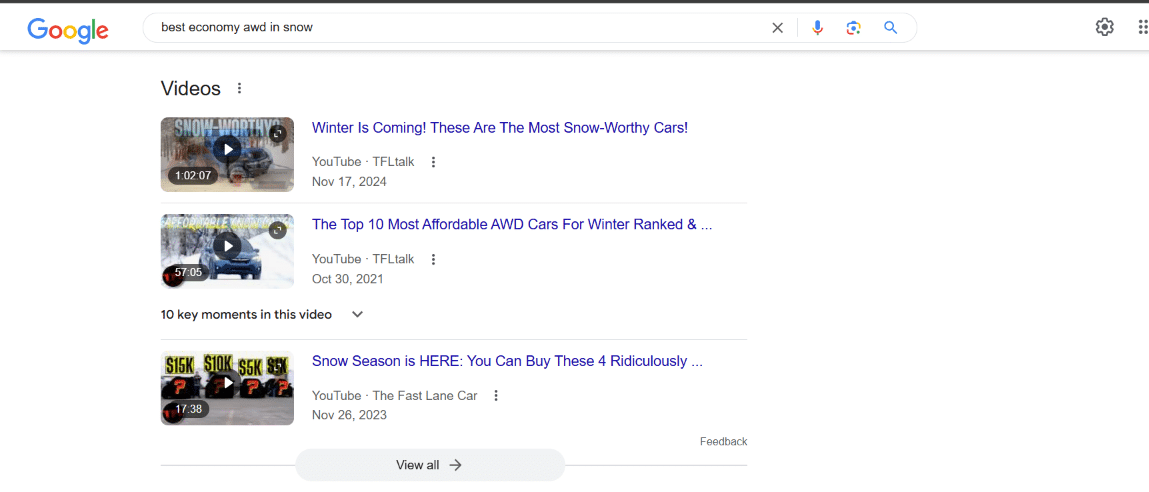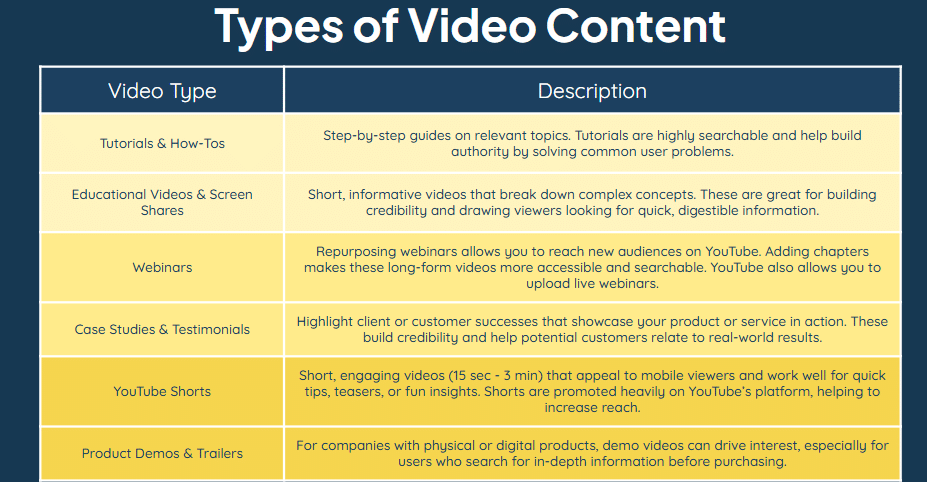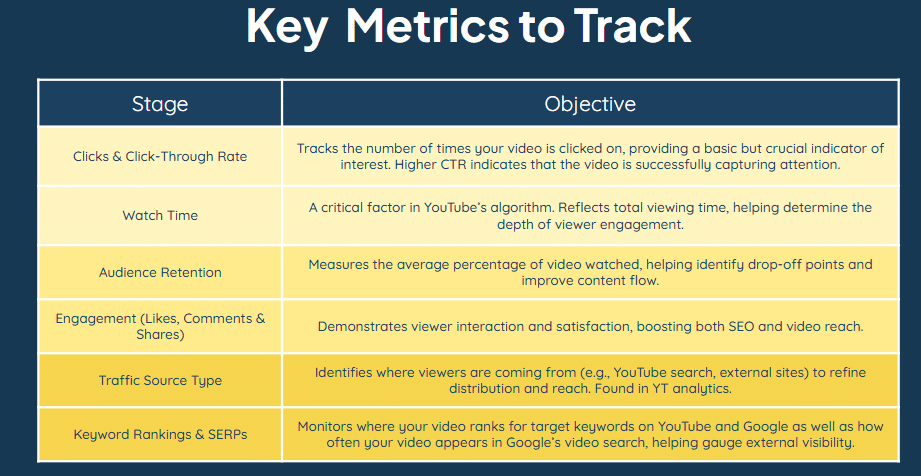7 video optimization tips to boost your organic reach in 2025

Even in 2025, as platforms like LinkedIn (not known for creativity) double down on video, many new clients coming to us still haven’t made it part of their organic strategy.
So, why should you invest in video?
Here are three key reasons:
- Increased SERP visibility: With a targeted strategy, YouTube videos have a higher chance of appearing prominently in the SERPs, enhancing brand visibility and driving organic traffic.

- Higher (and longer-lasting) engagement: Video content fosters deeper engagement, encouraging longer view times and generating sustained traffic over months or years.
- Multi-platform reach: Optimized videos could appear on both Google and YouTube (the world’s two largest search engines) and social media platforms, expanding brand visibility across channels.
None of this should be new information, right?
But much like reach campaigns, sometimes repeated exposure leads to eventual action.
If you’re inspired to ramp up your investment in video, let’s roll up our sleeves and get into optimization.
1. Analyze your current videos
Assuming you’ve posted some video content to YouTube, there’s plenty you can learn from and carry forward.
- Review all published videos to:
- Assess performance metrics, such as views, watch time, likes, comments, and shares.
- Identify videos that have performed well and analyze what elements (e.g., titles, thumbnails, topics) contributed to their relative success.
- Observe the length, format, and pacing of high-performing videos.
- Leverage platforms like TubeBuddy or vidIQ to find high watch times that can indicate especially valuable or entertaining content.
- Evaluate the effectiveness of current SEO strategies, including keyword usage in titles, descriptions, and tags. Even in top-performing videos, you may find gaps that, when filled in, will provide another bump in performance.
- Review comments and feedback from viewers to gain insights into audience preferences and suggestions for improvement. The more views your videos have, the more commentary they want to garner, so it’s fine to stick with analyzing your top performers here.
Dig deeper: The future of SEO content is video – here’s why
2. Analyze your competitors
Start with your top competitors. If they’re not active on YouTube, that’s good for you but not for research.
In that case, find competitors in your niche or related ones.
Once you’ve got your list of competitors, analyze their highest-engagement videos.
- Are their Shorts outperforming longer content?
- Are their webinars crushing it?
- Are there any production elements that seem common in their top videos?
Dig into the elements of the videos:
- Titles.
- Descriptions.
- Thumbnails.
- Video quality.
- Keyword usage.
- Thumbnail appeal.
- Overall video production
Your competitors’ audiences likely share many characteristics of your ICP (ideal customer profile), so mine their audience feedback for insights.
Check views, likes, comments, and shares to gauge audience interaction, identify successful content, and find opportunities to improve your own video strategy.
3. Refresh your keyword research
Using your Google keywords for video may be efficient, but it’s not always effective.
From a user perspective, people simply search differently on YouTube than they do on Google.
YouTube’s audience often searches for niche, visual content that may not have a high search volume on Google.
From a platform perspective, YouTube and Google carry different algorithms that reward different user behaviors.
Where Google favors content that gets clicks, YouTube’s algorithm favors engagement metrics like watch time, comments, and shares.
Choosing keywords that encourage viewers to watch longer and interact boosts content performance.
From a tools perspective, Google’s keyword planning and Semrush alone won’t get you the insights you need for video.
Consider using:
- Google Trends: Use the YouTube filter.
- vidIQ: Enter video topic, get relevant keywords.
- KeywoodTool.io: Explore the YouTube tab.
- The YouTube search bar: Look for autofill suggestions that indicate popular searches.
Dig deeper: Visual content and SEO: How to use images and videos in 2025
4. Sketch out your new-content strategy
Here’s how we break down video content’s types and use cases at my agency:

These won’t all be relevant for your brand, but the breakdown might be a good starting point for ideating new content to engage your audience.
Here are a few additional pointers as you roll up your sleeves and get filming:
- In general, authenticity (even in B2B) wins out over production, so emphasize your content’s value over bells and whistles.
- UGC is a great way to infuse E-E-A-T principles and social proof into your video content. Even if you don’t have the budget to bring on creators, employees can serve as effective advocates.
- Blog content can be a great source of inspiration for new videos:
- Review existing blog content to find topics that can be expanded into video formats. (Look for posts with high traffic or engagement metrics that indicate strong interest.)
- Use blog posts as scripts or outlines for videos. This saves time and ensures consistency in messaging.
- Break down long-form blog content into shorter, digestible video segments.
- Remember to embed videos in blog posts to increase engagement and provide additional context. Conversely, link to related blog posts in video descriptions to drive traffic back to your website.
Get the newsletter search marketers rely on.
See terms.
5. Tackle on-page optimizations
Starting with your existing videos and remembering to apply the principles to any new content, set aside time to refine these on-page SEO elements:
- Video titles and descriptions: Optimize with main keywords and compelling language for better engagement.
- Video thumbnail creation: Custom thumbnails attract clicks; relevant tags boost discoverability.
- Use end-screens and cards: Guide viewers to related videos, keeping them on your channel longer.
- Curate playlists: Organize related content to increase overall watch time.
- Enhance your search visibility with schema: Use video schema to boost the chances of videos appearing in rich snippets and search results, increasing click-through rates.
Dig deeper: The DESCRIBE framework for effective YouTube descriptions
6. Build your video presence away from Google
I work extensively with my clients to establish organic initiatives away from the Google ecosystem, and video should follow suit.
Repurposing content across channels won’t always be as simple as that, so consider these recommendations for extending your video presence.
On LinkedIn, short-form videos (under 2 minutes) work well for business updates, thought leadership, and industry insights. You can also repurpose YouTube Shorts if the content aligns.
You’ll need to adapt your content for Instagram Reels, TikTok, and Facebook, keeping each platform’s audience and style in mind.
For example, Reels and TikTok benefit from trending sounds and hashtags, while Facebook favors story-driven content.
Email marketing is a good fit for video. Add video links to newsletters (and calling video out in your subject lines) to boost click-through rates.
As with any email campaign, use segmented lists to personalize video content for specific audiences.
Leverage your network of partners to find influencers, podcasts, and webinar, where your content can be featured to reach new audiences.
Dig deeper: A guide to creating social media videos (for search and beyond)
7. Lock in your KPIs
Measurement is what quantifies the impact of the initiatives above.
Before breaking down video metrics, keep in mind that advanced analytics – through third-party tools or decision sciences – can track video’s impact on leads and purchases.
For now, let’s focus on upper-funnel measurement:

Along with the quantifiable impact of tracking these metrics, you’ll get directional data on the topics and trends that matter most to your ICP, which will inform future content.
Video content in 2025: Smarter SEO, more engagement, bigger reach
Video optimization is an ongoing process.
Like any organic strategy, it requires constant refinement and adaptation over time.
You’ll know video has the right place in your SEO strategy when it’s referenced as often as other content, with regular reporting and optimization updates.
Until then, you’re giving your competitors an opening to grab customer affinity and market share.
Don’t let more time pass before the next reminder to make 2025 the year of video finally sink in.
Dig deeper: A technical guide to video SEO









Recent Comments